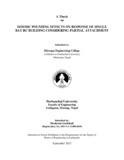Please use this identifier to cite or link to this item:
https://elibrary.khec.edu.np:8080/handle/123456789/710| Title: | SEISMIC POUNDING EFFECTS ON RESPONSE OF SINGLE BAY RC BUILDING CONSIDERING PARTIAL ATTACHMENT |
| Authors: | Gorkhali, Dashram |
| Advisor: | Er. Sudip Karanjit |
| Keywords: | Pounding|Non-Linear Time History Analysis|Partial Attachment Between Adjacent Buildings|Seismic Response of Single Bay RC building|Separation Gap |
| Issue Date: | Sep-2023 |
| College Name: | Khwopa Engineeering College |
| Level: | Masters |
| Degree: | ME Earthquake |
| Department Name: | P. G Department of Earthquake Engineering |
| Abstract: | Urban city like Kathmandu Valley which is located in seismically active regions, the population is increasing at a very tremendous rate, but the amount of land available is limited and also very costly. So, in order to accommodate a large population in such a limited costly space, buildings are being constructed very close to each other with very little or almost negligible separation gap between them. During the earthquake, buildings tend to undergo out of phase vibrations and due to non-availability of proper space required for vibrations, they collide with each other leading to hammering action between adjacent buildings. This hammering phenomenon tends to enlarge the seismic responses of a building by many folds. This effect is termed as pounding. After Gorkha earthquake much of the RCC buildings are build and still ongoing in Bhaktapur municipality and many are of single bay with above four stored and restricted to one, two or even three sides by other buildings. Many of the research in this sector have been done but we found rarely analysis considering partial attachment between adjacent buildings with same or different story level. Hence need to check pounding effects and determine seismic separation gap or effective reducing measures for those building if need to build in small field areas later to safely response the same level of earthquake. This is the main theme of this thesis which I think to adopt so that the outcomes could be informative for owners building homes in limited areas in the district today and the near future. The main objective of this study is to access seismic response of single bay RC building attached to other building partially. For this case, partially attached models of one bay building connected to adjacent two bay building with full face attached, two bay attached, one bay attached and corner point attached have been selected varying different number of storeys of 2 bay building . Non-linear time history analysis following Direct Integration method is performed using Chi-chi, Gorkha and North Ridge Earthquakes. Response of single bay building in terms of maximum displacement, absolute acceleration and pounding force are evaluated and compare between pounding and non-pounding cases. From the study we notice that effects of Poundings effects has been gradually decreases in connected buildings from full face attachment to 2 bay attachment to 1 bay attachment till corner point attachment in all types model cases of connected buildings. Higher displacement response has been observed for North Ridge earthquakes in all models for all partial attachment cases than other ground excitation of Gorkha and Chichi earthquakes time histories. Comparison between peak acceleration of single bay building and 2 bay building with different numbers of floors with different partial attachment clearly indicates that smaller stiff building will induce higher acceleration to tall buildings in floor of contact level. Furthermore pounding force has been raised to peak level when both building are on full face attachment then it goes on decreasing serially from 2 bay attachment, 1 bay attachment and finally lower response obtained for corner point connection. From the study we noticed that pounding force are greatly induce when single bay building is attached to adjacent buildings of lower stories than higher stories buildings. It also shows that taller structures are more likely to suffer greater damage when pounding occurs. According to SRSS rules mentioned by FEMA 273-1997, maximum separation gap has been observed for North Ridge level of earthquakes in all model cases. |
| URI: | https://elibrary.khec.edu.np:8080/handle/123456789/710 |
| Appears in Collections: | Master of Science (M.Sc) in Earthquake engineering |
Files in This Item:
| File | Description | Size | Format | |
|---|---|---|---|---|
| 018_Dashram Gorkhali.pdf Restricted Access | 3.81 MB | Adobe PDF |  View/Open Request a copy |
Items in DSpace are protected by copyright, with all rights reserved, unless otherwise indicated.
